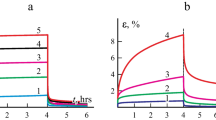Abstract
In the present paper, we propose and study a nonlinear constitutive relation for describing the one-dimensional isothermal rheological processes with monotone loading history in viscoelastoplastic materials. This relation presents the strain at any time moment in terms of the history of variations in the stress and its derivative by means of two integral operators and contains two material functions of the same real argument and ten material parameters determined by the results of tests on material creeping, long-term strength, and strain at a constant loading rate.
Under minimal a priori restrictions on the material parameters of the model, we derive the equations of strain, creep, relaxation, and long-term strength curves, analytically study the dependencies of their properties on parameters, and find necessary restrictions on the material parameters and functions ensuring an adequate description of the mechanical behavior of materials (the typical qualitative properties of experimental strain, creep, relaxation, and long-term strength curves).
To model the long-term strength in creeping, we propose two parametric families of fracture criteria under monotone uniaxial strain, which are related to the strain criterion but take into account the history of the strain increase by means of special integral operators relating this history to the damage measure. We prove that the constitutive relation thus constructed, along with the proposed fracture criteria, leads to theoretical long-term strength curves with the same qualitative properties as the experimental curves of a majority of metals.
Thus, an analysis of the properties of the proposed constitutive relation shows that it allows one to perform an adequate simulation not only of several effects of rheological behavior of viscoelastoplastic materials but of the entire complex of effects such as the strain dependence on the stress and the stress rate, relaxation, creeping, the creep rate dependence on the stress level, the long-term strength, and the material memory fading.
Similar content being viewed by others
References
A. V. Khokhlov, “Constitutive Relation for Rheological Processes: Properties of Theoretic Creep Curves and Simulation of Memory Decay,” Izv. Akad. Nauk. Mekh. Tverd. Tela, No. 2, 147–166 (2007) [Mech. Solids (Engl. Transl.) 42 (2), 291–306 (2007)].
A. V. Khokhlov, “Constitutive Relation for Rheological Processes with Known Loading History,” Electronic Journal “Investigated in Russia” 8, 355–365 (2005), http://zhurnal.ape.relarn.ru/articles/2005/032.pdf,.
W. A. Day, The Thermodynamics of Simple Materials with Fanding Memory (Springer-Verlag, Berlin, 1972; Mir, Moscow, 1974).
V. D. Klyushnikov, Physical-Mathematical Foundations of Strength and Plasticity (Isd-vo MGU, Moscow, 1994) [in Russian].
R. A. Vasin and F. U. Enikeev, Introduction to the Mechanics of Superplasticity (Gilem, Ufa, 1998) [in Russian].
O. V. Sosnin, B. V. Gorev, and A. F. Nikitenko, Energy Version of Creep Theory (Inst. Gidrodinamiki SO AN SSSR, Novosibirsk, 1986) [in Russian].
V. N. Kuznetsov, A. V. Khokhlov, and S. A. Shesterikov, “Constitutive Relations for Rheological Processes,” Electronic Journal “Investigated in Russia” 6, 152–160 (2003), http://zhurnal.ape.relarn.ru/articles/2003/016.pdf.
A. V. Khokhlov, “Criteria for Creep Fracture Taking into Account the Strain History, and Simulation of Long-Term Strength Curves,” Electronic Journal “Investigated in Russia” 8, 1010–1020 (2005), http://zhurnal.ape.relarn.ru/articles/2005/098.pdf.
A. V. Khokhlov, “An Extension of the Constitutive Equation for Rheological Processes and New Properties of the Theoretic Creep Curves,” in Advanced Methods in Validation and Identification of Nonlinear Constitutive Equations in Solid Mechanics (EUROMECH Colloquium 458) (Moscow, 2004), pp. 44–46.
Yu. G. Basalov, V. N. Kuznetsov, and S. A. Shesterikov, “Constitutive Relations for a Rheonomous Material,” Izv. Akad. Nauk. Mekh. Tverd. Tela, No. 6, 69–81 (2000) [Mech. Solids. (Engl. Transl.) 35 (6), 55–66 (2000)].
J. E. Fitzgerald and J. Vakili, “Nonlinear Characterization of Sand-Asphalt Concrete by Means of Permanentmemory Norms,” Proc. SESA 30(2), 504–510 (1960).
Yu. N. Rabotnov, Mechanics of Deformable Solids (Nauka, Moscow, 1988) [in Russian].
Yu. N. Rabotnov, Creep of Construction Elements (Nauka, Moscow, 1966) [in Russian].
A. M. Lokoshchenko, Creeping and Long-Term Strength of Metals in Aggressive Media (Isd-vo MGU, Moscow, 2000) [in Russian].
G. P. Karzov, B. T. Timofeev, T. A. Chernaenko, “Assessment of In-Service Degradation of Mechanical Properties of NPP Reactor and Piping Materials,” Probl. Prochn., No. 1, 100–105 (2004) [Strength of Materials (Engl. Transl.) 36 (1), 71–74 (2004)].
A. V. Khokhlov, “Approximation Properties of a Class of Piece Power-Law Functions and Their Use in Viscoelastoplasticity,” in Lomonosov Readings (Izd-vo MGU, Moscow, 2006), p. 145 [in Russian].
Author information
Authors and Affiliations
Corresponding author
Additional information
Original Russian Text © A.V. Khokhlov, 2008, published in Izvestiya Akademii Nauk Mekhanika Tverdogo Tela, 2008, No. 2, pp. 140–160.
About this article
Cite this article
Khokhlov, A.V. Constitutive relation for rheological processes with known loading history. Creep and long-term strength curves. Mech. Solids 43, 283–299 (2008). https://doi.org/10.3103/S0025654408020155
Received:
Published:
Issue Date:
DOI: https://doi.org/10.3103/S0025654408020155



